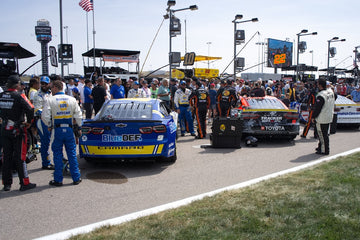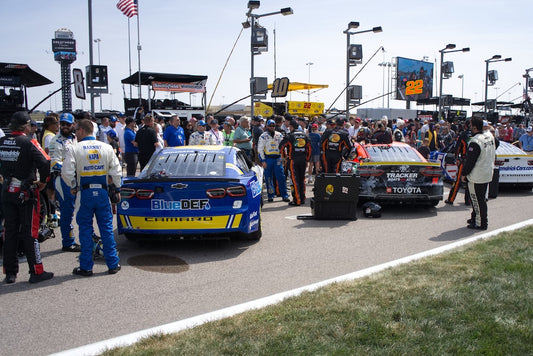Analyzing Weather's Significant Role in NASCAR Race Strategy

Weather conditions play a significant role in the sport of NASCAR. From rain to extreme heat and high winds, the weather can have a profound impact on race strategy. In this blog post, we will explore the effects of different weather conditions on NASCAR races and the challenges they present. We will also discuss the role of weather in race strategy and highlight interesting details about its impact. Additionally, we will examine real-life examples of how weather conditions have affected NASCAR races and the lessons learned from these experiences.
Weather Conditions and NASCAR Races
Rain is one of the most common weather conditions that can affect NASCAR races. It can lead to delays and even postponements of races. When rain hits the track, it becomes slippery, making it difficult for drivers to maintain control of their cars. This necessitates the use of rain tires, which have a different tread pattern to provide better grip on wet surfaces. Additionally, rain can affect pit stops, as teams may need to make adjustments to tire choices and fuel calculations based on the changing conditions.
Extreme heat can also have a significant impact on NASCAR races. It affects the track temperature, which in turn affects tire grip. As the track temperature rises, tire grip decreases, making it harder for drivers to maintain control of their cars. To counteract this, teams may need to adjust tire pressure and setup to maximize grip and prevent tire wear. Furthermore, extreme heat can lead to driver fatigue, making it crucial for teams to manage their drivers' physical and mental well-being throughout the race.
High winds can create challenges for NASCAR drivers as well. Strong gusts of wind can affect the handling of the car, making it more difficult for drivers to maintain stability on the track. Teams must develop strategies to deal with wind gusts, such as adjusting the car's aerodynamics to minimize the impact of crosswinds. Aerodynamics play a crucial role in NASCAR races, and teams must find a balance between maximizing speed and maintaining stability in windy conditions.
Weather Challenges
Rain delays can significantly impact race plans. Teams must reassess their strategies and make changes to fuel calculations and tire choices based on the new weather conditions. Contingency plans must be assessed to ensure that teams are prepared for any unexpected changes. Rain delays require teams to think on their feet and adapt quickly to the changing circumstances.
Tire management is always important in NASCAR races, but it becomes even more critical when weather conditions are a factor. Teams must select and manage tires based on the specific weather conditions they are facing. Different types of tires are used in various weather conditions, such as slick tires for dry conditions and rain tires for wet surfaces. Proper tire selection and management can have a significant impact on a team's performance and race strategy.
Weather conditions, particularly rain, can significantly impact track conditions. When rain hits the track, it can make the surface slippery and affect driver speed and technique. Drivers must adapt their driving styles to the changing track conditions and find the optimal racing line to maintain control of their cars. Teams must also be prepared to make adjustments to their strategies based on the evolving track conditions.
Weather in NASCAR Race Strategy
Tire grip is crucial in NASCAR races, as it determines how well the car can grip the track and maintain control. Weather conditions, particularly hot weather, can affect track temperature, which in turn affects tire grip. As the track temperature rises, tire grip decreases, making it challenging for drivers to maintain control of their cars. Teams must make adjustments to maximize grip and prevent tire wear, such as adjusting tire pressure and setup.
Rain delays can have a significant impact on race strategy. Teams must adapt their plans and make changes to pit stop strategies based on the changing weather conditions. Rain delays may require teams to make unexpected adjustments to their race plans, such as altering fuel calculations and tire choices. Contingency plans become crucial in these situations, as teams must be prepared for any unexpected changes that may occur due to weather conditions.
Tire and fuel management are essential aspects of NASCAR races, and weather conditions play a significant role in these strategies. Different weather conditions require different tire selections and management approaches. Teams must carefully consider the weather forecast and make decisions on tire choices based on the expected conditions. Additionally, weather conditions can affect fuel consumption, and teams must adapt their strategies to conserve fuel and maximize performance based on the specific weather conditions they are facing.
Impact of Weather
- Tire grip and track temperature: Hot weather can lead to changes in tire pressure, affecting tire grip on the track. As the track temperature rises, teams must make adjustments to tire pressure to maintain optimal grip. Changes in tire pressure can have a significant impact on driver control and speed, as drivers must adapt to the changing conditions to maintain control of their cars.
- Rain delays and strategy shifts: Rain delays often result in unexpected changes in race plans. Teams must be prepared to make quick decisions and adapt their strategies based on the evolving weather conditions. Contingency plans become crucial in these situations, as teams must have backup plans in place to ensure they can navigate the race effectively, even in challenging weather conditions.
- Tire management: Different types of tires are used in various weather conditions to optimize performance and grip. Slick tires are used in dry conditions, while rain tires are used on wet surfaces. Proper tire selection and management are essential for teams to maximize their performance and adapt to the specific weather conditions they are facing.
Examples of Weather's Impact on Racing
In the 2021 NASCAR Cup Series race at Charlotte Motor Speedway, weather played a significant role in the race strategy. Rain delays resulted in multiple stoppages and forced teams to reassess their plans and make quick decisions to adapt to the changing conditions.
The rain delays in the Charlotte Motor Speedway race led teams to make changes in fuel calculations and tire choices. Contingency plans were put into action, and teams had to navigate the changing weather conditions to maximize their performance. The race showcased the importance of adaptability and quick decision-making in NASCAR race strategy.
The Charlotte Motor Speedway race provided valuable lessons for teams in terms of weather strategy. Teams recognized the importance of having contingency plans in place and the need to adapt quickly to changing weather conditions. The race highlighted the significance of tire management and fuel conservation in NASCAR races affected by weather.
Conclusion
Weather conditions have a significant impact on NASCAR race strategy. From rain to extreme heat and high winds, teams must navigate the challenges presented by these conditions and make adjustments to maximize performance. Tire grip, rain delays, and tire management are just a few of the key factors influenced by weather in NASCAR races.


